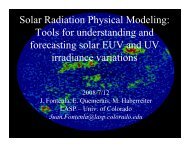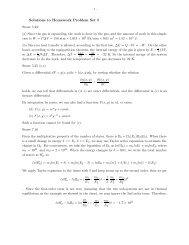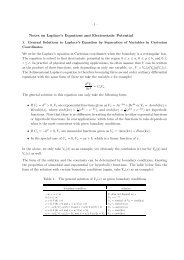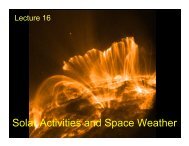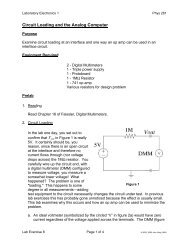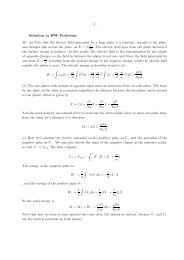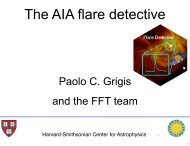312 Lab Manual - Solar Physics at MSU - Montana State University
312 Lab Manual - Solar Physics at MSU - Montana State University
312 Lab Manual - Solar Physics at MSU - Montana State University
You also want an ePaper? Increase the reach of your titles
YUMPU automatically turns print PDFs into web optimized ePapers that Google loves.
•M<strong>at</strong>erials<br />
diffraction gr<strong>at</strong>ing<br />
helium lamp<br />
oxygen lamp<br />
hydrogen lamp<br />
sodium lamp<br />
mystery lamp<br />
•Introduction<br />
Spectra I<br />
The figure below is an example of several spectra<br />
from each stellar spectral class. In each<br />
spectra, you can see not only wh<strong>at</strong> colors are<br />
emitted, but also dark lines, called absorption<br />
lines. The continuous spectrum is cre<strong>at</strong>ed by<br />
the hot glowing gas in the low-lying levels of<br />
the star’s <strong>at</strong>mosphere. The absorption lines are<br />
cre<strong>at</strong>ed when this light flows outward through<br />
the upper layers of the star’s <strong>at</strong>mosphere. Atoms<br />
in these upper layers absorb radi<strong>at</strong>ion <strong>at</strong><br />
specific wavelengths, which depend on the specific<br />
kinds of <strong>at</strong>oms present. Scientists group<br />
stars with similar spectra into spectral classes.<br />
Above or below the diagram, label the following<br />
absorption lines:<br />
1) Hα: red, strong in the mid spectral classes<br />
2) He I: yellow, strong from O to K<br />
3) Hβ: blue-green, strong from B5 to F5<br />
4) Na I: yellow, strong in M<br />
5) Hγ: blue, strong in B and A stars.<br />
You may be wondering wh<strong>at</strong> the symbols α, β,<br />
and I refer to. Hα is the symbol for hydrogen<br />
alpha, the Balmer alpha electron transition for<br />
hydrogen. Similarly for Hβ, only the Balmer beta<br />
transition. Refer to your text for more inform<strong>at</strong>ion<br />
on energy level transitions. I refers to the<br />
fact th<strong>at</strong> helium in this case is not ionized. He II<br />
is helium th<strong>at</strong> has lost one electron, Fe IX has<br />
lost eight electrons, and so on.<br />
A gas made of a certain element has its own<br />
characteristic absorption lines. In this lab, you<br />
will look <strong>at</strong> spectra from several gases, making<br />
detailed observ<strong>at</strong>ions of the lines. This will prepare<br />
you for the next lab, Spectra II, where you<br />
will actually analyze the spectra of some stars<br />
and identify their chemical makeup by observing<br />
their absorption lines.<br />
•Procedure<br />
1) Your lab instructor has several gas lamps,<br />
one with helium gas, one with hydrogen gas,<br />
one with oxygen gas, one with sodium gas, and<br />
a mystery lamp (you have to guess wh<strong>at</strong>’s in<br />
it). You will be given a diffraction gr<strong>at</strong>ing, which<br />
works like a prism, spreading out the wavelengths<br />
of light. As the instructor turns on each<br />
lamp, hold the diffraction gr<strong>at</strong>ing to your eye so<br />
you see a spread of colors. There are only two<br />
orient<strong>at</strong>ions for the diffraction gr<strong>at</strong>ing, one th<strong>at</strong><br />
you will be able to see the bands and one you<br />
won’t. Ask your lab instructor if you cannot make<br />
out the bands. Write or draw your observ<strong>at</strong>ions.<br />
2) Although each lamp cannot be on for more<br />
than about 30 seconds, your instructor will turn<br />
on each lamp several times. Draw in the absorption<br />
lines you see in the appropri<strong>at</strong>e boxes<br />
on the following page.<br />
Spectra I<br />
Copyright:<br />
KPNO 0.9-m<br />
telescope,<br />
AURA, NOAO,<br />
NSF<br />
11



